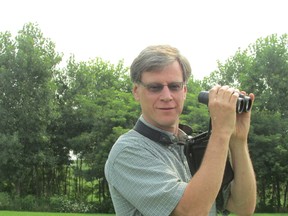New Bird Studies boss a seasoned vet

Article content
Steven Price, the incoming president of Bird Studies Canada, is bringing a great depth of experience and impressive enthusiasm to his new work.
He takes the reins this week and is poised to build upon the solid foundational work that was led by Dr. George Finney who is retiring after a decade at the helm of the organization.
Bird Studies Canada’s role as the country’s leading national bird organization is important to the community, whether casual birders are aware of its roles in research and conservation or not.
Without BSC’s work such as their State of Canada's Birds report and breeding bird atlases, we would be ill-equipped to identify and respond to avian challenges and broader ecological issues.
I sat down with Price in Port Rowan this month to chat about his new role and the organization’s direction. Before we got to my questions however, we were comparing notes about the birds we had seen that morning, birding inspiration, and hot spots. His passion for birds is unmistakeable.
I was also interested to learn that his links with BSC are long-standing too, having been on the board of the Long Point Birding Observatory in the 1980s.
Price, who specialized in wetland ecology and conservation during post-graduate work at the University of Toronto, worked for more than 30 years with World Wildlife Fund Canada. Most recently he was its international program director. He was also the founding director of WWF Canada’s conservation science and practice team.
This leadership experience and track record in conservation will transfer well. When Price was at WWF, he even partnered with BSC’s Long Point Birding Observatory, sponsoring the first Cuban exchange of ornithologists and bird banders. He also met success in work with the forest industry and organizations such as the Toronto-based Fatal Light Awareness Program.
Innovative partnering is a theme that Price spoke of as a key to success in addressing BSC’s future science, conservation, and education programs. “Non-governmental organizations won’t save the world on their own.”
“Bird Studies is in a unique spot in the centre of a triangle with governments and industry and academia. It takes common objectives of course, but it also takes courage and experience to be a truly effective partner.”
Early this fall BSC will unveil the organization’s new five-year strategic plan, laying out how the organization will build on its core activities. “Bird Studies is at the forefront of developing sound science to reveal trends in bird populations and priorities for their conservation.” said Price.
National and international co-ordination of citizen science work will continue. The Christmas Bird Count, Project FeederWatch (CCT), Project NestWatch (CCT), the Great Backyard Bird Count, and use of eBird are some of these initiatives that bird watching enthusiasts may know about.
The long view on the growing threat of climate change will also shape research and conservation work in coming years.
Several times through the interview, Price came back to an “acid test” theme. “The birds should be better off as a result of BSC’s efforts. And we want to do more than having birds that aren’t endangered. We need ecosystems that thrive for birds and for us.”
BSC has had good success in important research initiatives that range from marsh monitoring to nocturnal owl surveys. “The end goal is not the research or press releases however. What matters is whether or not the birds are better off.”
Nature notes
- Four pairs of Acadian flycatchers nested at Hawk Cliff this summer. This species is endangered both provincially and nationally. The birds were monitored by BSC staff.
- The Hawk Cliff Hawk Watch on Lake Erie east of Port Stanley commences in September. While birding there recently I saw Jim Dunn who alerted me to area birders’ recent sightings. A dozen species of early warbler migrants have been seen. Hawk Cliff regular Mary Carnahan also advised of vireo and flycatcher species, tanagers, and orchard orioles. I was happy to see ruby-throated hummingbirds in the jewelweed and a Nashville warbler.
- September 1 marks the 100th anniversary of the extinction of the passenger pigeon. The last of these birds died at the Cincinnati Zoo. Just 50 years earlier there were billions (CCT) of these birds across North American.
Paul Nicholson can be reached at g.paul.nicholson@gmail.com. Twitter @NicholsonNature